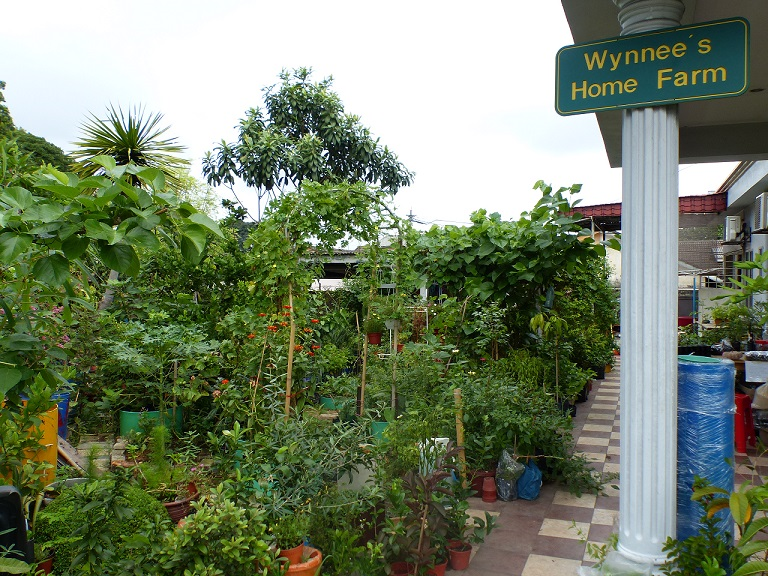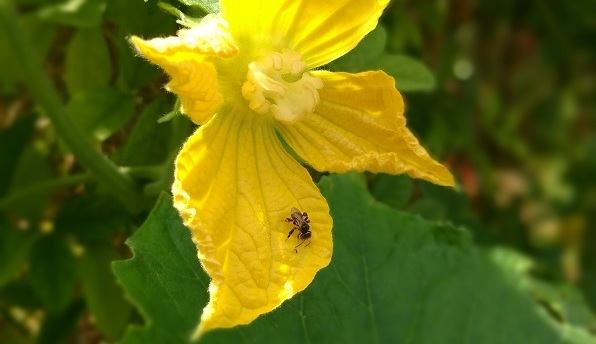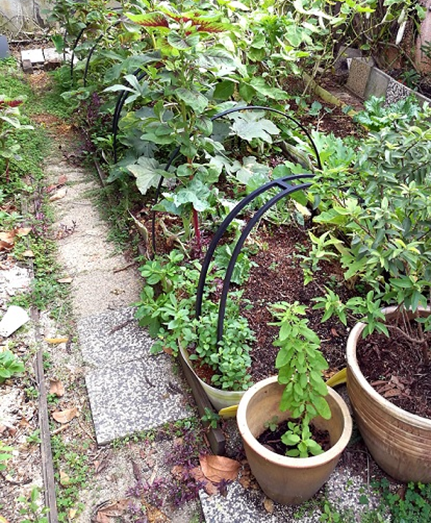THE GARDEN WARRIOR

WE ARE TOP 10 AGAIN FOR 14 CONSECUTIVE YEARS
November 8, 2016
PROPERTY INVESTORS ARE BECOMING PROFESSIONAL AIRBNB HOSTS
November 29, 2016 Edible gardens have been around since the time man had a patch of earth and learned to cultivate. In the past, it was commonplace to plant fruit trees, herbs and a vegetable or two in the available surrounding lands near our homes. Skipping forward to today’s urban environment coupled with land scarcity and rising food prices, edible gardens have gained a new resurgence amongst urbanites. More and more of us today are conscientious about where our food comes from, if the source is local, sustainable and even organic.
Edible gardens have been around since the time man had a patch of earth and learned to cultivate. In the past, it was commonplace to plant fruit trees, herbs and a vegetable or two in the available surrounding lands near our homes. Skipping forward to today’s urban environment coupled with land scarcity and rising food prices, edible gardens have gained a new resurgence amongst urbanites. More and more of us today are conscientious about where our food comes from, if the source is local, sustainable and even organic.
Wynnee Goh, an avid home gardener, is hardly a newcomer to the scene. Manager of Wynnee’s Home Farm in Klang, she has honed her admirable nurturing abilities from the wee age of seven. Growing up in a kampung accorded her a lot of land to indulge in planting greens, which she did vehemently, inculcating the same habits and discipline evident in her home farm today. Back then, the fruits of her labour were harvested by her family as well as her father’s workers for their own consumption. Today, Wynnee also shares and exchanges her produce besides selling them.

Looking at her prolific outdoors, it is easy to assume that a lot of time is spent here. Various pots and raised beds dotting the landscape, garden walls covered with an intricate network of pumpkin vines and flowering creepers, sturdy trelisses supporting heavyset wintermelons all bear evidence to such dedicated craft. Wynnee humbly describes this as a passionately pursued hobby. The farm was initially tended to mainly after work at night or on the weekends. She then decided to further embrace her love for gardening and took a paycut which allowed for fewer days at the office and more time doing what she loved best.
 The entire home garden ecosystem is self-sustainable as Wynnee believes in natural pest control by means of symbiotic relationships and companion planting. Grasshoppers, butterflies, snails and frogs all roam free. “The water hyacinth plants attract frogs which in turn will eat other insects and help control the snail population. Besides, a plant that is under attack by any predators will give me a good indication that it is weak, as critters only go after plants that emit a certain ‘hormone’ to indicate susceptibility,” she explains. The marigold plant, an effective companion plant positioned next to the spinach, acts as a natural pest repellent when planted beside the vegetable. Honolulu creepers attract bees and the tiny, aquatic azolla plant, or more commonly known as water fern, traps nitrogen from the air and disperses it into the water, making it a powerful biofertiliser.
The entire home garden ecosystem is self-sustainable as Wynnee believes in natural pest control by means of symbiotic relationships and companion planting. Grasshoppers, butterflies, snails and frogs all roam free. “The water hyacinth plants attract frogs which in turn will eat other insects and help control the snail population. Besides, a plant that is under attack by any predators will give me a good indication that it is weak, as critters only go after plants that emit a certain ‘hormone’ to indicate susceptibility,” she explains. The marigold plant, an effective companion plant positioned next to the spinach, acts as a natural pest repellent when planted beside the vegetable. Honolulu creepers attract bees and the tiny, aquatic azolla plant, or more commonly known as water fern, traps nitrogen from the air and disperses it into the water, making it a powerful biofertiliser.
Nestled between all the greens is a small hut which is home to the garden’s little miracle workers – stingless bees. A much-loved pollinator, one hive yields half a kilogramme of honey in one month. There were several hives planted strategically throughout the place which she gets from her friend’s farm in Janda Baik, Pahang. Wynnee adds, “The bees assimilate quite well into their environment, they will only abandon the hive under severe threats. Stingless bees can still bite though.”

Stingless bees help pollinate the flowers in the garden.
Wynnee also staunchly opines that the key to a perpetually healthy plant is healthy soil. In general, two methods of fertilisation are used at her home farm; ground fertilisation using compost and aerial fertilisation using spray. A lot of care and monitoring goes into the composting process which she also makes available for purchase. While both methods are used – aerobic and anaerobic – anaerobic composting is preferred as less space is required to do it and one can add in even cooked foods and meats. “Composting promotes sustainability. About 30% of our waste is food waste and anaerobic composting allows you to compost nearly all of it with the exception of big whole bones, liquids and rotten foods.”

Wynnee’s homemade Bokashi bin.
As further proof of her ardent habit, Wynnee has savvily converted a nondescript plastic bin to be equipped with a raised platform and a drainage hole that fits a tap, thus creating a vessel to contain her anaerobic compost.
She then sprinkles her own compost starter, bokashi, which is Japanese for fermented organic matter. It is made up of rice bran, molasses and effective microbes, layered into the bin with compost matter, then repeating the process before letting it ferment for two weeks before transferring it to further compost another two weeks in the ground.
After just the fourth day of fermentation however, the liquid can already be drained out twice a week onwards and used as a potent natural fertiliser. It will need to be diluted in a ratio of 5 millilitre to 1 litre of water prior to use.
An effective way of dispersing liquid fertiliser is the use of foliar spray. This technique, according to Wynnee, sprays fertiliser directly onto the leaves (as opposed to just adding compost to the soil) is 300 times more effective than traditional soil fertilisation, as plants can only absorb a maximum of 20% using the latter method before it all leaches away into the ground. “The best times to do a foliar spray however is either prior to 8am or post 7pm as the stomatas of the leaves only open in low temperatures,” she cautions.
At the far end of her garden, we come upon large drums containing traditional compost using aerobic bacteria comprising egg shells, coffee grounds, horse dung, seaweed and even mushroom waste. The thermophilic bacteria which causes temperatures to rise to as high as 60 degrees Celsius will aid in killing pathogens. The egg shells that Wynnee collects from various waste disposals are also used to make calphos, a calcium and phosphorous rich fertiliser made from any form of shells. “Calphos helps to induce flowering and prevent plants from aborting their fruits,” Wynnee explains.
Fermented Plant Extracts or FPE is another excellent natural fertiliser for plants apart from compost. Similar to fermented fruit enzymes we drink as a health tonic, this method involves the use of several bacteria that break down the enzymes of the plant producing a rich organic liquid plant food. To hasten a process that normally takes three months to just a month, effective microorganisms are added to the extract. Wynnee elaborates, “EM.1 which is primarily made out of lactobacillus bacteria and phototropic bacteria is added to the organic matter and then it is kept in a cool dark place. This is to prevent sunlight which contains UV rays from killing the microbes.” Wynnee makes her own seaweed and banana FPEs, with the latter being especially effective in enhancing the sweetness of fruits.


Through all these means of natural fertilisation deployed in her home farm, no form of chemical fertiliser is necessary. “It (chemical fertilisers) can give lushness immediately, however the effect does not last long. The chemicals will end up killing the microbes in the soil and what you end up with is ‘dead’ soil,” Wynnee explains.
Wynnee and her other friends call themselves the “Garden Warriors”. They challenge limiting beliefs of conventional home-farming and are always pushing the boundaries by keeping their options (and gardens) open to less familiar and popular plants. Olives, asparagus, cabbages, peaches, plums, curly kale, indian gooseberry are being acclimatised to the tropical heat in her garden. “I am not sure myself if the process will be successful but I am willing to try. Figs come from the Mediterranean and yet they managed to fruit here. In fact some plants are able to flower and fruit all year round as compared to their native soil,” Wynnee enthuses.

Besides the usual suspects of okra, brinjal, winter melon, spearmint, there are also latest trending fruits that people are beginning to express interest in cultivating. Fig trees, originally hailing from the temperate Middle East, have been acclimatised and are thriving in Wynnee’s garden. Harvesting a ripe piece to try, the fruit was sweet, pulpy and soft. It is unsurprising then that some cultures refer to the fig as the “Fruit from Heaven”. Fig leaves have now made their way on our dinner tables too as edible wrappings for baked fish!
Our conversation with Wynnee was interspersed with arrivals of other gardening enthusiasts. Most took leisurely strolls while admiring the foliage and others came prepared with pots to transplant home their purchases. We asked about her interaction with these individuals and also how it extends to online support such as forums and Facebook groups. “Those who pay a visit will seek advice about their pest problems, non-thriving fruits, or ask how I manage that particular plant in my garden. Some will bring pictures for further analysis. For the online community, I will post pictures from my garden to inspire them, to show them that is doable.” Wynnee also participates in car boot sales to not only reach out to the public but also as an effort to foster better ties with the tight-knit group of gardeners. “They are all my friends and we will show up to spend some time together as well as exchange plants,” she adds.
We also asked how people living in high-rise buildings could also indulge in this edible garden effort, despite the obvious lack of land; Wynnee suggests, “They can start by planting herbs or even the tiny Brazilian spinach. As long as there is a balcony with full sunlight, it should be sufficient. One can always plant in pots or even attempt vertical planting. In fact, grafting has produced smaller, dwarf-sized fruit trees that can easily find a home in an apartment as well.” Those with difficulty finding a sunny spot can consider investing in grow lights which are commonly used for indoor planting. Supermarkets use them to enhance the shelf life of their leafy produce.
Wynnee and her home garden are an inspiration for many who wish to grow their own food. Debunking the need for green thumbs, she is a reminder that all we need to invest in is a little time and a lot of patience as plants being living things require our care and nurture too.
Wynnee’s tips on how beginners can start their edible garden: –
- Connect with other fellow gardener Most gardeners are more than willing to share and exchange their expertise, tips and help troubleshoot problems.
- Learn how to compost. They make great fertiliser while also reducing waste that goes to the landfills.
- Save extra seeds. They can be planted in the future or used to exchange with others for seeds that you do not have.
- Start small. To not be overwhelmed and abandon the garden halfway; plant vegetables such as okra, sawi and kangkung before moving on to fruits trees and other foreign plants.
- Enjoy your garden. It is a great way to reduce stress, encourage bonding with family members while putting high-nutrition food on the table. More appreciation stems from knowing the effort put in to produce food free from chemicals and pesticides.
For further enquiries on composting, organic gardening or to visit Wynnee’s home farm, call her at 012-6292526. Wynnee lives in Klang.




